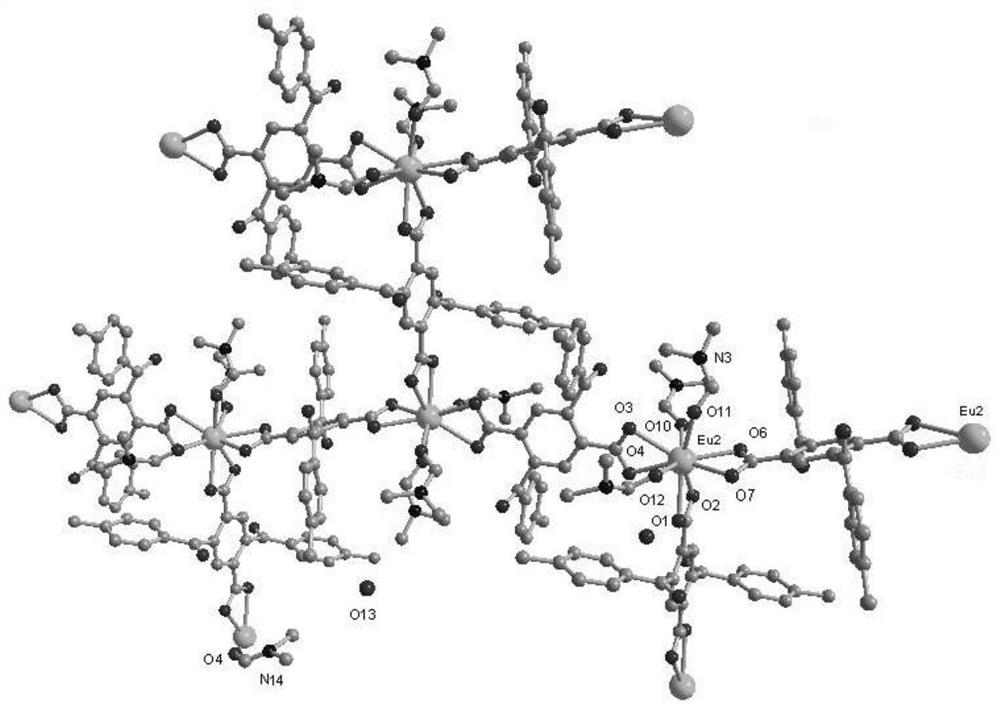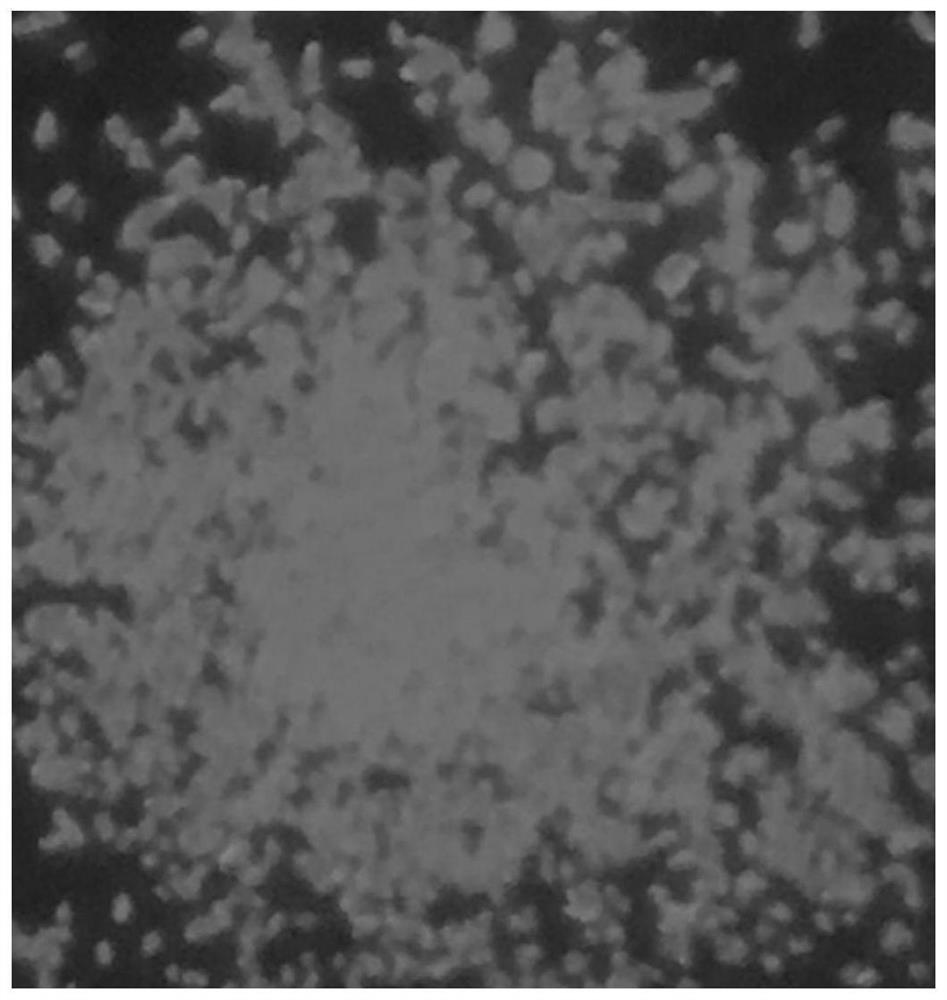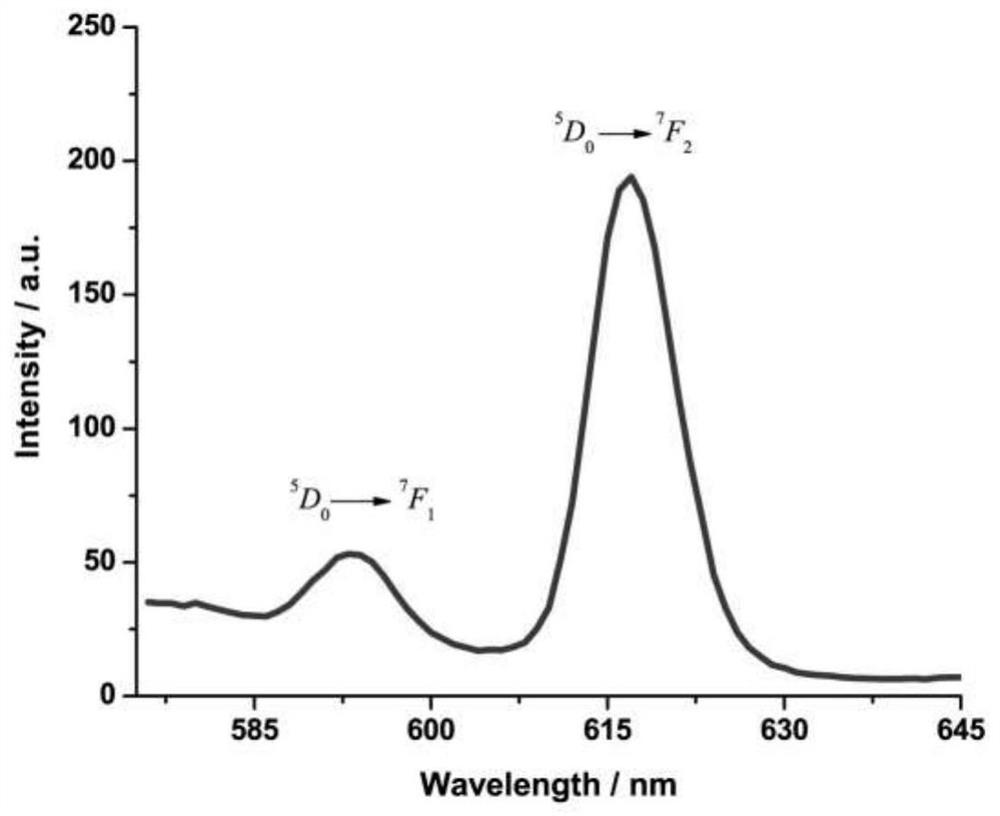A kind of network structure rare earth europium (iii) coordination polymer and its preparation method and application
A technology of coordination polymer and network structure, applied in the field of fluorescent probes, achieves the effects of simple device and operation, easy separation and purification of products, good fluorescence intensity and monochromaticity
- Summary
- Abstract
- Description
- Claims
- Application Information
AI Technical Summary
Problems solved by technology
Method used
Image
Examples
Embodiment 1
[0038] Add 0.13mmol of 2,5-bis(4-methylbenzoyl)terephthalic acid to a round-bottomed flask, add 12mL of water and DMF (volume ratio 1:5) mixed solvent, add sodium hydroxide Adjust the pH of the solution to 5-6, heat to reflux to dissolve it, then add 0.08 mmol of europium nitrate hexahydrate to the mixed solution, continue heating to reflux, cool, and transfer the obtained mixed solution into a glass test tube. On the liquid surface in the test tube, first add 3 mL of a mixed solvent composed of water and ethanol (volume ratio 1:2), and then add 4 mL of ethanol solution in which 0.10 mmol o-phenanthroline is dissolved, and the solution in the test tube is divided into three layers. Cover the mouth of the test tube with a preservative film with small holes, let it stand at room temperature, and obtain a colorless crystal product in the lower layer of the test tube after two weeks.
Embodiment 2
[0040] Add 0.11mmol of 2,5-bis(4-methylbenzoyl)terephthalic acid to a round bottom flask, add 12mL of water and DMF (volume ratio 1:5) mixed solvent, add sodium hydroxide Adjust the pH of the solution to 5-6, heat to reflux to dissolve it, then add 0.10 mmol of europium nitrate hexahydrate to the mixed solution, continue to heat and reflux, cool, and transfer the obtained mixed solution into a glass test tube. On the liquid surface in the test tube, first add 3 mL of a mixed solvent composed of water and methanol (volume ratio 1:2), and then add 5 mL of ethanol solution in which 0.10 mmol o-phenanthroline is dissolved, and the solution in the test tube is divided into three layers. The preservative film that has punched aperture covers test tube mouth, leaves standstill at room temperature, obtains the same product as embodiment 1 at the lower floor of test tube after two weeks.
Embodiment 3
[0042] Add 0.15mmol 2,5-bis(4-methylbenzoyl)terephthalic acid to a round bottom flask, add 12mL of water and DMF (volume ratio 1:5) mixed solvent, add sodium hydroxide Adjust the pH of the solution to 5-6, heat to reflux to dissolve it, then add 0.06 mmol of europium nitrate hexahydrate to the mixed solution, continue heating to reflux, cool, and transfer the obtained mixed solution into a glass test tube. On the liquid surface in the test tube, first add 3 mL of a mixed solvent composed of water and methanol (volume ratio 1:2), and then add 6 mL of methanol solution in which 0.10 mmol o-phenanthroline is dissolved, and the solution in the test tube is divided into three layers. The preservative film that has punched aperture is covered test tube mouth, left standstill at room temperature, obtains the same product as embodiment 1 in the lower floor of test tube after two weeks.
[0043] For the molecular structure of the network structure rare earth europium (III) coordination...
PUM
 Login to View More
Login to View More Abstract
Description
Claims
Application Information
 Login to View More
Login to View More - Generate Ideas
- Intellectual Property
- Life Sciences
- Materials
- Tech Scout
- Unparalleled Data Quality
- Higher Quality Content
- 60% Fewer Hallucinations
Browse by: Latest US Patents, China's latest patents, Technical Efficacy Thesaurus, Application Domain, Technology Topic, Popular Technical Reports.
© 2025 PatSnap. All rights reserved.Legal|Privacy policy|Modern Slavery Act Transparency Statement|Sitemap|About US| Contact US: help@patsnap.com



